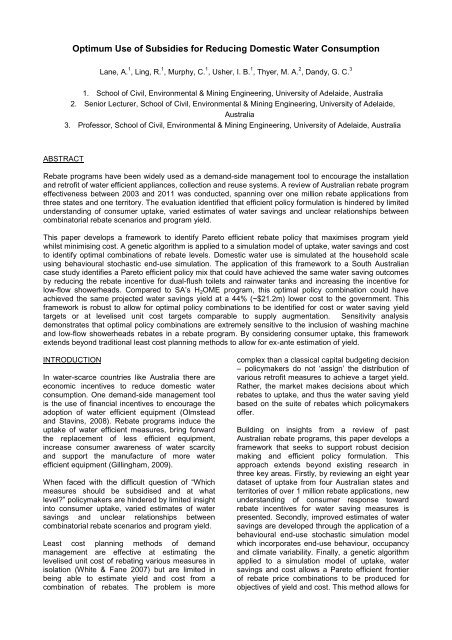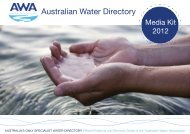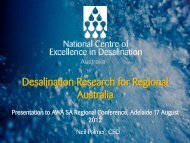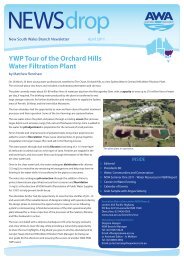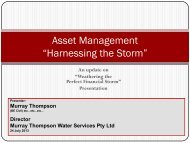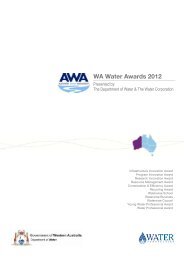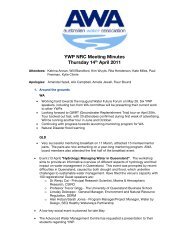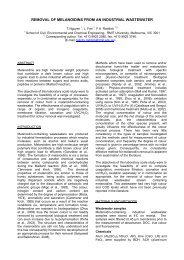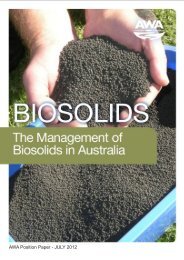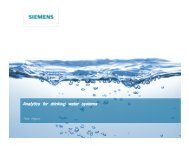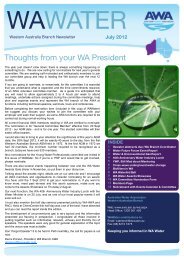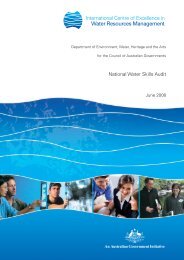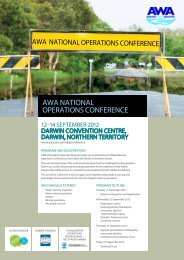Optimum Use of Subsidies for Reducing Domestic Water Consumption
Optimum Use of Subsidies for Reducing Domestic Water Consumption
Optimum Use of Subsidies for Reducing Domestic Water Consumption
Create successful ePaper yourself
Turn your PDF publications into a flip-book with our unique Google optimized e-Paper software.
<strong>Optimum</strong> <strong>Use</strong> <strong>of</strong> <strong>Subsidies</strong> <strong>for</strong> <strong>Reducing</strong> <strong>Domestic</strong> <strong>Water</strong> <strong>Consumption</strong><br />
Lane, A. 1 , Ling, R. 1 , Murphy, C. 1 , Usher, I. B. 1 , Thyer, M. A. 2 , Dandy, G. C. 3<br />
1. School <strong>of</strong> Civil, Environmental & Mining Engineering, University <strong>of</strong> Adelaide, Australia<br />
2. Senior Lecturer, School <strong>of</strong> Civil, Environmental & Mining Engineering, University <strong>of</strong> Adelaide,<br />
Australia<br />
3. Pr<strong>of</strong>essor, School <strong>of</strong> Civil, Environmental & Mining Engineering, University <strong>of</strong> Adelaide, Australia<br />
ABSTRACT<br />
Rebate programs have been widely used as a demand-side management tool to encourage the installation<br />
and retr<strong>of</strong>it <strong>of</strong> water efficient appliances, collection and reuse systems. A review <strong>of</strong> Australian rebate program<br />
effectiveness between 2003 and 2011 was conducted, spanning over one million rebate applications from<br />
three states and one territory. The evaluation identified that efficient policy <strong>for</strong>mulation is hindered by limited<br />
understanding <strong>of</strong> consumer uptake, varied estimates <strong>of</strong> water savings and unclear relationships between<br />
combinatorial rebate scenarios and program yield.<br />
This paper develops a framework to identify Pareto efficient rebate policy that maximises program yield<br />
whilst minimising cost. A genetic algorithm is applied to a simulation model <strong>of</strong> uptake, water savings and cost<br />
to identify optimal combinations <strong>of</strong> rebate levels. <strong>Domestic</strong> water use is simulated at the household scale<br />
using behavioural stochastic end-use simulation. The application <strong>of</strong> this framework to a South Australian<br />
case study identifies a Pareto efficient policy mix that could have achieved the same water saving outcomes<br />
by reducing the rebate incentive <strong>for</strong> dual-flush toilets and rainwater tanks and increasing the incentive <strong>for</strong><br />
low-flow showerheads. Compared to SA‟s H 2 OME program, this optimal policy combination could have<br />
achieved the same projected water savings yield at a 44% (~$21.2m) lower cost to the government. This<br />
framework is robust to allow <strong>for</strong> optimal policy combinations to be identified <strong>for</strong> cost or water saving yield<br />
targets or at levelised unit cost targets comparable to supply augmentation. Sensitivity analysis<br />
demonstrates that optimal policy combinations are extremely sensitive to the inclusion <strong>of</strong> washing machine<br />
and low-flow showerheads rebates in a rebate program. By considering consumer uptake, this framework<br />
extends beyond traditional least cost planning methods to allow <strong>for</strong> ex-ante estimation <strong>of</strong> yield.<br />
INTRODUCTION<br />
In water-scarce countries like Australia there are<br />
economic incentives to reduce domestic water<br />
consumption. One demand-side management tool<br />
is the use <strong>of</strong> financial incentives to encourage the<br />
adoption <strong>of</strong> water efficient equipment (Olmstead<br />
and Stavins, 2008). Rebate programs induce the<br />
uptake <strong>of</strong> water efficient measures, bring <strong>for</strong>ward<br />
the replacement <strong>of</strong> less efficient equipment,<br />
increase consumer awareness <strong>of</strong> water scarcity<br />
and support the manufacture <strong>of</strong> more water<br />
efficient equipment (Gillingham, 2009).<br />
When faced with the difficult question <strong>of</strong> “Which<br />
measures should be subsidised and at what<br />
level” policymakers are hindered by limited insight<br />
into consumer uptake, varied estimates <strong>of</strong> water<br />
savings and unclear relationships between<br />
combinatorial rebate scenarios and program yield.<br />
Least cost planning methods <strong>of</strong> demand<br />
management are effective at estimating the<br />
levelised unit cost <strong>of</strong> rebating various measures in<br />
isolation (White & Fane 2007) but are limited in<br />
being able to estimate yield and cost from a<br />
combination <strong>of</strong> rebates. The problem is more<br />
complex than a classical capital budgeting decision<br />
– policymakers do not „assign‟ the distribution <strong>of</strong><br />
various retr<strong>of</strong>it measures to achieve a target yield.<br />
Rather, the market makes decisions about which<br />
rebates to uptake, and thus the water saving yield<br />
based on the suite <strong>of</strong> rebates which policymakers<br />
<strong>of</strong>fer.<br />
Building on insights from a review <strong>of</strong> past<br />
Australian rebate programs, this paper develops a<br />
framework that seeks to support robust decision<br />
making and efficient policy <strong>for</strong>mulation. This<br />
approach extends beyond existing research in<br />
three key areas. Firstly, by reviewing an eight year<br />
dataset <strong>of</strong> uptake from four Australian states and<br />
territories <strong>of</strong> over 1 million rebate applications, new<br />
understanding <strong>of</strong> consumer response toward<br />
rebate incentives <strong>for</strong> water saving measures is<br />
presented. Secondly, improved estimates <strong>of</strong> water<br />
savings are developed through the application <strong>of</strong> a<br />
behavioural end-use stochastic simulation model<br />
which incorporates end-use behaviour, occupancy<br />
and climate variability. Finally, a genetic algorithm<br />
applied to a simulation model <strong>of</strong> uptake, water<br />
savings and cost allows a Pareto efficient frontier<br />
<strong>of</strong> rebate price combinations to be produced <strong>for</strong><br />
objectives <strong>of</strong> yield and cost. This method allows <strong>for</strong>
posterior articulation <strong>of</strong> preferences from decisionmakers<br />
and ex-ante estimation <strong>of</strong> yield. That is, a<br />
trade-<strong>of</strong>f curve allows optimal policy combinations<br />
that achieve a target yield or operate within a<br />
limited budget to be identified. Our framework also<br />
allows economically efficient rebate policy<br />
combinations which deliver programs at, or below,<br />
the long run marginal cost <strong>of</strong> supply to be<br />
identified.<br />
BACKGROUND: AUSTRALIAN REBATE<br />
PROGRAMS 2003 to 2011<br />
Between 2003 and 2011, water authorities in all<br />
Australian mainland states and territories<br />
implemented programs that provided rebates to<br />
households that installed or retr<strong>of</strong>itted a number <strong>of</strong><br />
water saving measures. The most commonly<br />
subsidised measures included dual-flush toilets,<br />
low-flow showerheads and the installation <strong>of</strong><br />
rainwater collection and reuse systems.<br />
Identifying the water savings achieved from each<br />
installation or retr<strong>of</strong>it is inadequate when<br />
estimating the effectiveness <strong>of</strong> demand side<br />
management policy at a regional or state-wide<br />
scale. Yield from a water resources management<br />
perspective is achieved when water savings from<br />
individual measures are multiplied by uptake. To<br />
gain a better understanding <strong>of</strong> how consumers<br />
respond to rebate incentives, water authorities in<br />
five Australian states and two territories were<br />
contacted between April and June 2011 to obtain<br />
historical rebate uptake data. Data was obtained<br />
from programs in South Australia, Victoria,<br />
Western Australia and the Australian Capital<br />
Territory.<br />
Rebate programs in these states have had<br />
success in inducing households to install or retr<strong>of</strong>it<br />
water saving measures. Over 1 million successful<br />
rebate applications were paid representing at least<br />
$115 million <strong>of</strong> government spending. By June<br />
2011, programs in South Australia, Western<br />
Australia, Victoria and the Australian Capital<br />
Territory had encouraged 46 357 households to<br />
replace their showerheads, 40 755 dwellings to<br />
install a dual flush toilet, 86 068 residences to<br />
install a rainwater tank and 344 200 households to<br />
purchase a water efficient washing machine.<br />
For finer scale analysis, rebate applications were<br />
disaggregated by product type and program then<br />
expressed as cumulative uptake normalised by the<br />
number <strong>of</strong> residential water connections in the<br />
state. Analysis reveals that the most popular <strong>for</strong>m<br />
<strong>of</strong> rebate claimed by consumers was <strong>for</strong> new<br />
WELS 4-star or higher rated washing machines.<br />
Over a five and seven year program, rebates <strong>for</strong><br />
washing machines achieved uptake <strong>of</strong> 25.5% and<br />
30.4% in SA and WA respectively. This compares<br />
to rainwater tanks – 2.35% and 5.86%; low-flow<br />
showerheads – 3.44% and 2.66% and swimming<br />
pool covers – 0.52% and 4.50%, all <strong>for</strong> SA and WA<br />
respectively.<br />
Interstate comparisons reveal variation in uptake<br />
rates <strong>for</strong> the same product are largely independent<br />
<strong>of</strong> rebate level. For instance, a $30 rebate <strong>for</strong> lowflow<br />
showerheads was <strong>of</strong>fered in SA whilst a $10<br />
rebate was paid in WA. Despite this, monthly rates<br />
<strong>of</strong> uptake, normalised <strong>for</strong> the difference in<br />
residential households in each state, were largely<br />
similar (0.59 v 0.54%/mth). Analysis <strong>of</strong> the timing<br />
and intensity <strong>of</strong> advertising <strong>of</strong> rebate initiatives<br />
revealed strong correlation between uptake rates<br />
and marketing ef<strong>for</strong>t. Rebate programs may affect<br />
the adoption <strong>of</strong> water saving measures by simply<br />
increasing awareness <strong>of</strong> water efficiency rather<br />
than through explicit financial means.<br />
Rebate incentives aimed to induce the installation<br />
<strong>of</strong> rainwater tanks achieved greater relative<br />
success in South Australia compared to other<br />
states. Monthly rates <strong>of</strong> uptake <strong>for</strong> standalone<br />
rainwater tanks (1.84%/mth) and indoor reuse<br />
connected tanks (0.73%/mth) exceeded programs<br />
in Victoria (0.02% and 0.01%, per month) and<br />
Western Australia (0.29% per month). Apart from<br />
the influence <strong>of</strong> rebate level - the SA rebate <strong>for</strong><br />
standalone tanks was $150 greater than that<br />
<strong>of</strong>fered in WA and $50 greater than that <strong>of</strong>fered in<br />
Victoria – the pre-rebate penetration rate <strong>of</strong><br />
rainwater tanks in South Australian homes<br />
compared to the national average (45.4% v 19.3%)<br />
potentially explains this difference. Greater<br />
acceptability <strong>of</strong> rainwater harvesting and reuse<br />
may be inherent amongst South Australians.<br />
Climatic factors may also explain the increased<br />
uptake in South Australia relative to Victoria over<br />
the rebate period. Adelaide‟s Mediterranean<br />
rainfall pattern – long, dry summers and wet<br />
winters – provides incentive <strong>for</strong> households to<br />
„store‟ rainwater in the winter <strong>for</strong> use in the<br />
summer. We later demonstrate through end use<br />
modelling that this perceived benefit <strong>of</strong> rainwater<br />
tanks is flawed – more effective rainwater tank<br />
utilisation is achieved when larger volumes <strong>of</strong><br />
water are continually used throughout the year.<br />
This leads to potential implications <strong>for</strong> program<br />
<strong>for</strong>mulation. Policymakers in areas with consistent<br />
rainfall where the public may perceive little benefit<br />
in capturing rainwater may need to do more to<br />
encourage uptake.<br />
Statistical analysis <strong>of</strong> rebate applications paired<br />
with in<strong>for</strong>mation about the household revealed<br />
some socio-economic insights into the adoption <strong>of</strong><br />
water efficient equipment. Mirroring the findings <strong>of</strong><br />
Millock & Nauges (2010) who were limited by their<br />
use <strong>of</strong> a stated preference survey dataset; chi<br />
square tests per<strong>for</strong>med on South Australian rebate<br />
applications show that home owners are more<br />
likely to adopt water saving measures than<br />
tenants. Normalised <strong>for</strong> the proportions <strong>of</strong> home<br />
owners and tenants in South Australia, 30 times as
many rebates were paid to home owners<br />
compared to renters <strong>for</strong> dual-flush toilets and<br />
rainwater tanks. Even <strong>for</strong> low-flow showerheads,<br />
which have minimal installation difficulty and low<br />
capital costs, uptake was 16 times higher (3.93% v<br />
0.24%) in the home owner group compared to the<br />
tenant group. Washing machines were the only<br />
measure with higher uptake in the tenant group<br />
compared to the home owner group. Over the five<br />
year H 2 OME program, approximately 1 in 3 tenants<br />
claimed a rebate <strong>for</strong> the purchase <strong>of</strong> a new<br />
washing machine compared to only 1 in 5 home<br />
owners in South Australia. Regression analyses <strong>of</strong><br />
postcode median aggregate income against the<br />
postcodes <strong>of</strong> rebate applicants accept, at the 5%<br />
level, a null hypothesis that income is not an<br />
influence on rebate program participation.<br />
Together, these results have implication <strong>for</strong><br />
efficient policy <strong>for</strong>mulation.<br />
We infer that the adoption <strong>of</strong> water saving<br />
measures which do not add to consumer utility<br />
beyond a water saving benefit – low-flow<br />
showerheads and dual-flush toilets – are limited<br />
amongst groups with minimal financial incentive 1 to<br />
save water. On the other hand, rebate uptake <strong>for</strong><br />
measures that add a utility externality beyond<br />
water efficiency – washing machines – is relatively<br />
independent <strong>of</strong> the financial motivation <strong>for</strong> reducing<br />
domestic water consumption. It may be that<br />
subsidies <strong>for</strong> washing machines are being paid to<br />
consumers who have already made a purchasing<br />
decision independent <strong>of</strong> rebate incentive. This<br />
leads to Pareto inefficiency caused by the free<br />
rider problem. Subsidy levels <strong>for</strong> measures like<br />
washing machines need to be set at the typical<br />
price differential between WELS 4-star appliances<br />
and more inefficient models.<br />
By June 2011, many programs had ended or been<br />
scaled back. Results <strong>of</strong> our cost efficiency analysis<br />
identified that in the South Australian scheme lowflow<br />
showerheads, pool covers and front-loader<br />
washing machines rebates were able to achieve<br />
levelised unit costs to the Policymaker <strong>of</strong> $0.45/kL,<br />
$2.03kL and $2.38/kL – all less than the $2.40/kL<br />
long run marginal cost <strong>of</strong> potable water – as shown<br />
in Figure 1. Similarly, the role <strong>of</strong> a rebate reduces<br />
the payback period <strong>of</strong> a 1kL standalone rainwater<br />
tank and dual flush toilet by 10 and 8 years<br />
respectively. From the perspective <strong>of</strong> the<br />
consumer, only low-flow showerhead rebates<br />
allowed water savings to be achieved below the<br />
$2.48/kL tariff block at which most households are<br />
charged.<br />
While rebate programs have proved popular,<br />
questions can be raised about whether their costefficiency<br />
could have been improved by altering<br />
1 Landlords, rather than tenants in South Australia, generally<br />
pay the water supply and first 136kL <strong>of</strong> volumetric tariff<br />
charge.<br />
the combination and rebate level <strong>of</strong> water saving<br />
measures. A $150 rebate <strong>for</strong> a single dual flush<br />
toilet has the opportunity cost to policymakers <strong>of</strong><br />
subsidising five low-flow showerheads at $30 each.<br />
Would subsidising only the most cost efficient<br />
measures such as low-flow showerheads produce<br />
meaningful volumes <strong>of</strong> yield What combination <strong>of</strong><br />
subsidy level would generate sufficient uptake to<br />
deliver water savings at or below the long run<br />
marginal cost <strong>of</strong> supply The first question requires<br />
estimates <strong>of</strong> uptake response whilst the second<br />
question represents a decision space <strong>of</strong> order 10 11<br />
combinations <strong>for</strong> 20 common measures and 9<br />
possible prices.<br />
METHOD: A NEW FRAMEWORK FOR PARETO<br />
EFFICIENT REBATE POLICY<br />
A review <strong>of</strong> Australian examples identifies that<br />
policymakers exert influence over the response <strong>of</strong><br />
consumers to a rebate program through a number<br />
<strong>of</strong> policy decisions. These decision variables<br />
include the measures which should be included in<br />
a rebate program, the level <strong>of</strong> rebate <strong>for</strong> these<br />
measures, the duration <strong>of</strong> the program, the<br />
intensity and timing <strong>of</strong> advertising campaigns and<br />
the conditions attached to rebate eligibility.<br />
Additionally, a number <strong>of</strong> conditions outside the<br />
control <strong>of</strong> policymakers influence the uptake and<br />
subsequently, the water saving and cost response.<br />
Based on data constraints, our analysis simplifies<br />
the problem and decision space – policymakers<br />
are assumed to influence uptake through only two<br />
decisions - whether or not to subsidise a measure<br />
and the level at which a subsidy should <strong>of</strong>fered <strong>for</strong><br />
that measure.<br />
Our approach investigates the trade-<strong>of</strong>f that exists<br />
between how much a policymaker is willing to<br />
spend and the volume <strong>of</strong> water savings that can be<br />
achieved <strong>for</strong> different rebate policy combinations.<br />
Using the understanding gained from the analysis<br />
<strong>of</strong> Australian rebate uptake, paired with original<br />
estimates <strong>of</strong> water savings; three models – uptake,<br />
water savings and cost – are proposed to evaluate<br />
conflicting objectives seeking to<br />
1) minimise the cost <strong>of</strong> the rebate program<br />
2) maximise the volume <strong>of</strong> water savings<br />
A genetic algorithm, NSGA-II (Deb et al., 2002) in<br />
a spreadsheet-based implementation (Savic et al.,<br />
2011) is applied to develop the Pareto frontier <strong>of</strong> all<br />
non-dominated combinations <strong>of</strong> rebate policy. The<br />
two decision variables – whether or not a rebate<br />
should be <strong>of</strong>fered <strong>for</strong> a given measure; and the<br />
level at which a rebate <strong>for</strong> that measure should be<br />
<strong>of</strong>fered – are represented in the chromosome <strong>of</strong><br />
the genetic algorithm. This chromosome <strong>of</strong> 20-bit<br />
length is <strong>for</strong>mulated using integer coding with each<br />
bit representing a different water saving measure.<br />
These include four „non-tank‟ measures – low-flow<br />
showerheads, dual flush toilets, 4-star washing
machines and pool covers and 16 combinations <strong>of</strong><br />
rainwater tank measures representing 1, 2, 4,and<br />
9kL tanks with end-use connectivity to either<br />
outdoor; outdoor and toilet; outdoor and laundry; or<br />
outdoor, toilet and laundry end uses. A bit coding<br />
<strong>of</strong> „1‟ indicates that a rebate <strong>of</strong> $0 should apply to<br />
the measure – i.e. it should not be subsidised - and<br />
a coding <strong>of</strong> „2‟ through „9‟ represent increasing<br />
increments <strong>of</strong> subsidy as a proportion <strong>of</strong> the typical<br />
acquisition and installation cost <strong>of</strong> the measure.<br />
Forecasting Uptake<br />
To demonstrate the proposed optimization<br />
framework, uptake <strong>for</strong> a given policy combination is<br />
<strong>for</strong>ecasted using observed relationships derived<br />
from analysis <strong>of</strong> Australian programs. That is, we<br />
model uptake <strong>for</strong> a low-flow showerhead rebate <strong>of</strong><br />
$30 in South Australia to occur at the same rate as<br />
the observed South Australian data fitted to a<br />
linear regression. To <strong>for</strong>ecast consumer response<br />
to rebates at other, previously un<strong>of</strong>fered and<br />
unobserved prices, we apply the economic concept<br />
<strong>of</strong> elasticity - the ratio <strong>of</strong> percentage change <strong>of</strong> one<br />
variable to the percentage change in another<br />
variable – as a method to estimate response to a<br />
new policy <strong>of</strong> rebate prices. A price elasticity <strong>of</strong><br />
rebate uptake, , is proposed in Eq 1 to<br />
measure the responsiveness <strong>of</strong> the cumulative<br />
uptake rate <strong>of</strong> rebates to a change in rebate level.<br />
A value <strong>of</strong> 1.658 was derived from Victorian uptake<br />
data. The level <strong>of</strong> uptake at each time step, shown<br />
in Eq 2, is a major driving input into the cost and<br />
water saving models.<br />
Eq<br />
1<br />
Eq<br />
2<br />
Where Hs represents the number <strong>of</strong> households<br />
within the target area, is the empirically<br />
derived price elasticity <strong>of</strong> rebate uptake, is<br />
the observed rate <strong>of</strong> uptake <strong>for</strong> a measure k at an<br />
observed rebate level <strong>of</strong> , represents<br />
the slope coefficient <strong>of</strong> cumulative normalised<br />
uptake <strong>for</strong> a new rebate level, , and is the<br />
number <strong>of</strong> months from the start <strong>of</strong> the rebate<br />
program.<br />
Evaluating Cost<br />
The objective <strong>of</strong> cost is evaluated from the<br />
perspective <strong>of</strong> the policymaker. At each monthly<br />
time step, the rebate level <strong>for</strong> a given measure,<br />
plus an administrative loading, is multiplied by the<br />
number <strong>of</strong> rebates taken up. These costs are<br />
discounted back to a net present value. Cost can<br />
also be evaluated from the perspective <strong>of</strong> program<br />
participants, society or a weighted sum <strong>of</strong> all three.<br />
An 8% discount rate is applied in addition to a 12%<br />
administrative cost loading based on empirical<br />
estimates <strong>of</strong> Western Australia‟s <strong>Water</strong>wise<br />
program.<br />
Evaluating <strong>Water</strong> Savings<br />
The objective <strong>of</strong> water saving is assessed by<br />
evaluating the sum <strong>of</strong> water savings achieved in<br />
the duration <strong>of</strong> the rebate program (Eq 3) and the<br />
annual yield achieved by measures after the<br />
conclusion <strong>of</strong> a rebate program.<br />
Eq 3<br />
Where U t,k is the cumulative uptake <strong>of</strong> a water<br />
saving measure k in a given time t, φ k is the<br />
monthly water saving value <strong>for</strong> a given measure k<br />
as predicted using the dataset <strong>of</strong> water savings,<br />
DSL is the length <strong>of</strong> the decision string, equal to<br />
the number <strong>of</strong> potential rebate options; PL is the<br />
length <strong>of</strong> the rebate program, NSL is the net saving<br />
life <strong>of</strong> the measures and NRR is the non-rebate<br />
replacement factor, the percent <strong>of</strong> water savings<br />
measures that would have been uptaken without a<br />
rebate <strong>of</strong>fered.<br />
Evaluating <strong>Water</strong> Savings using an Integrated<br />
Urban <strong>Water</strong> Management Model<br />
Highly variable estimates <strong>of</strong> water savings from<br />
largely similar water saving measures exist in<br />
literature and between „online efficiency<br />
calculators‟ published by many Australian water<br />
authorities. Our approach demonstrates the<br />
application <strong>of</strong> a behavioural stochastic end-use<br />
model to create improved estimates <strong>of</strong> water<br />
savings achievable by the rebate-induced<br />
installation <strong>of</strong> water saving measures.<br />
The Behavioural End-<strong>Use</strong> Stochastic Simulator<br />
(„BESS‟) (Thyer et al. 2011) in e<strong>Water</strong> Urban<br />
Developer (Breen et al., 2006) is applied to create<br />
datasets <strong>of</strong> water savings achieved when a water
saving measure is installed. Urban Developer is a<br />
water balance model which simulates discrete enduse<br />
events and allows <strong>for</strong> source substitution from<br />
rainwater tanks. Indoor behavioural patterns from a<br />
Residential End-<strong>Use</strong> Study by Roberts (2005) and<br />
outdoor end-use data from Barton (2003), Loh and<br />
Coghlan (2003) and Coombes and Kuczera (2003)<br />
are used <strong>for</strong> Adelaide, Perth and Melbourne<br />
respectively. Temperature, rainfall and evaporation<br />
data <strong>for</strong> January 2001 to December 2010 from<br />
Adelaide, Perth and Tullamarine Airports and<br />
household occupancy distributions from the 2006<br />
Census are used as model inputs. A simulation <strong>of</strong><br />
annual water demand <strong>for</strong> a household <strong>of</strong> typical<br />
size, appliance stock and occupancy is run to<br />
create a baseline reference <strong>for</strong> each <strong>of</strong> the three<br />
case study locations. Appliance efficiencies such<br />
as toilet and showerhead standards are then<br />
changed and the model resimulated to obtain an<br />
annual water demand due to rebate-induced<br />
demand management.<br />
Our analysis identified extreme variability in water<br />
saving yield <strong>for</strong> rainwater tanks due to climate<br />
differences. For instance, 1kL rainwater tanks used<br />
<strong>for</strong> outdoor irrigation provide 7.67kL/year <strong>of</strong><br />
avoided mains demand in Adelaide compared to<br />
15.13kL/year <strong>of</strong> avoided mains demand in<br />
Melbourne. <strong>Water</strong> saving yield from indoor retr<strong>of</strong>its<br />
depend on behaviour and occupancy whilst water<br />
saving yield from rainwater tanks depend on<br />
rainfall, ro<strong>of</strong> area connectivity ratio, re-use<br />
configuration and tank size.<br />
These estimates differ to arbitrary yield models<br />
used by many policymakers – Victorian savings<br />
estimates are based on an assumption that a<br />
rainwater tank <strong>of</strong> any size will fill and empty 7.5<br />
times a year <strong>for</strong> outdoor irrigation. A 9kL rainwater<br />
tank connected to outdoor end-uses was estimated<br />
to yield water savings 7kL/year higher than our<br />
predictions. Through the use <strong>of</strong> an integrated<br />
urban water management model, our approach<br />
balances both rainwater harvesting potential and<br />
end-use demand to accurately model mains<br />
reduction achieved by rainwater tanks.<br />
POTENTIAL POLICY & DISCUSSION<br />
This framework is demonstrated to develop a<br />
Pareto efficient trade<strong>of</strong>f curve <strong>for</strong> two case study<br />
programs – Western Australia and South Australia.<br />
This is demonstrated in Figure 2. The x-axis<br />
represents the water savings achieved by a rebate<br />
program - accounted <strong>for</strong> during a rebate program<br />
<strong>of</strong> arbitrary five years and then assuming<br />
measures have an average „net saving life‟ <strong>of</strong> five<br />
years after the conclusion <strong>of</strong> the program. The y-<br />
axis represents cost to the policymaker, expressed<br />
as a levelised unit cost – the cost <strong>of</strong> all rebate<br />
measures and administrative costs, adjusted <strong>for</strong><br />
the opportunity cost <strong>of</strong> capital; divided by the water<br />
savings achieved.<br />
The shape <strong>of</strong> the Pareto curve demonstrates the<br />
trade-<strong>of</strong>f which exists in achieving greater volumes<br />
<strong>of</strong> water savings. At lower target water savings, the<br />
genetic algorithm identifies low-flow showerheads<br />
are the most cost-effective solution leading to<br />
improved cost efficiency. To encourage greater<br />
uptake and larger water savings, rebate levels<br />
increase, leading to reduced cost efficiency.<br />
Toward the right <strong>of</strong> the Pareto curve, the least cost<br />
efficient measures – indoor end-use connected<br />
rainwater tanks – become part <strong>of</strong> the Pareto<br />
optimal combination <strong>of</strong> rebates. Subsidising only<br />
the most cost efficient <strong>of</strong> measures – low-flow<br />
showerheads – achieves limited volumes <strong>of</strong> yield<br />
The two curved lines in Figure 2 represent all nondominated<br />
combinations <strong>of</strong> policy <strong>for</strong> South<br />
Australia (lower) and Western Australia (upper).<br />
The Western Australian frontier lies further within<br />
the optimal space – more efficient solutions are<br />
able to be achieved due to higher observed uptake<br />
<strong>of</strong> measures at lower rebate levels compared to<br />
the observed South Australian program.<br />
The two horizontal lines represent estimates <strong>of</strong> the<br />
long-run marginal cost <strong>of</strong> supply – that is, the<br />
levelised cost associated with the next possible<br />
expansion in supply - in Western Australia<br />
($1.08/kL) and South Australia ($2.40/kL). Points<br />
on the Pareto frontier which lie below these lines<br />
represent policy configurations which would induce<br />
sufficient uptake in order to deliver water savings<br />
lower than the cost <strong>of</strong> supply expansion. The<br />
intersection <strong>of</strong> the curved Pareto frontier and the<br />
horizontal lines <strong>of</strong> long run marginal cost represent<br />
economically efficient and Pareto optimal solutions.<br />
For South Australia, this corresponds to rebate<br />
policy which applies rebates <strong>of</strong> half <strong>of</strong> the retail<br />
cost to indoor appliances and pool covers,<br />
delivering a program cost <strong>of</strong> $101.3m and an<br />
estimated water saving <strong>of</strong> 42.55GL <strong>for</strong> a 10-year<br />
period.<br />
Applying an optimisation algorithm which evaluates<br />
the entire Pareto front in one run facilitates<br />
posterior articulation <strong>of</strong> preferences from<br />
policymakers. They are able to identify the various<br />
configurations <strong>of</strong> policy which are able to meet<br />
objectives at either constrained budgets or <strong>for</strong><br />
target water savings.<br />
On this chart we also model reference points <strong>of</strong><br />
past Western Australian and South Australian<br />
programs. These correlate to the water savings<br />
and cost which could have occurred given the<br />
actual numbers <strong>of</strong> uptake, evaluated with our water<br />
savings dataset and cost model. These reference<br />
points exclude the water savings achieved by, and<br />
costs incurred from, measures our demonstration<br />
did not include due to lack <strong>of</strong> data but were part <strong>of</strong><br />
the programs – e.g. garden measures,<br />
groundwater bores. This allows <strong>for</strong> a „like <strong>for</strong> like‟<br />
comparison. Immediately evident on this chart is
the fact that these two reference points lie within<br />
the dominated area <strong>of</strong> the Pareto curve. The<br />
horizontal distance that these points lie above the<br />
curve, multiplied by the water savings achieved,<br />
represents the potential cost savings which could<br />
have been realised if rebate choices and prices<br />
were optimally <strong>for</strong>mulated. For South Australia, this<br />
represents removing rebates <strong>for</strong> 1000L tanks,<br />
reducing the rebate incentive <strong>for</strong> washing<br />
machines and most tank rebate options and<br />
increasing the rebate incentive <strong>for</strong> showerheads<br />
and pool covers to $60 and $300 respectively.<br />
CONCLUSION<br />
This research develops and demonstrates a new<br />
framework <strong>for</strong> Australian and international<br />
policymakers to <strong>for</strong>mulate optimal rebate policies<br />
<strong>for</strong> water saving measures to reduce household<br />
water consumption. Multi-objective genetic<br />
algorithm optimisation techniques were<br />
successfully applied <strong>for</strong> the first time in this context<br />
to allow policymakers to develop a Pareto efficient<br />
frontier <strong>of</strong> optimal policy mixes.<br />
A review <strong>of</strong> historical rebate programs produces<br />
new knowledge about the drivers and expected<br />
response <strong>of</strong> Australian consumers to rebate<br />
programs. Applying behavioural end-use stochastic<br />
simulation, this research demonstrates a new<br />
method <strong>of</strong> estimating water savings from retr<strong>of</strong>it<br />
and rainwater tank installation measures.<br />
Through the application <strong>of</strong> a <strong>for</strong>mal optimisation<br />
framework, our results demonstrate that improved<br />
economic and environmental outcomes can be<br />
achieved. Current methods <strong>of</strong> evaluating program<br />
success – through ex-post economic analysis – are<br />
plagued as they are retrospective and <strong>of</strong>ten rely on<br />
poor or exaggerated water savings estimates.<br />
Least cost planning methods which identify the<br />
levelised cost <strong>of</strong> measures in isolation are useful<br />
only to <strong>for</strong>mulate policy when budgets are<br />
unconstrained. Our framework improves upon<br />
both through ex-ante estimation <strong>of</strong> yield and cost<br />
with an uptake model, improved estimates <strong>of</strong> water<br />
savings and consideration <strong>of</strong> measures in<br />
combination.<br />
Table 1 – Potential improvements from the application <strong>of</strong><br />
the proposed framework <strong>for</strong> three case study schemes<br />
SA<br />
WA<br />
Previous Rebate<br />
Scheme<br />
Economically<br />
Efficient<br />
At Similar <strong>Water</strong><br />
Saved<br />
Previous Rebate<br />
Scheme<br />
Economically<br />
Efficient<br />
At Similar <strong>Water</strong><br />
Saved<br />
Cost<br />
($m)<br />
<strong>Water</strong><br />
Saved<br />
(GL)<br />
$/kL<br />
$48.2 19.3 2.50<br />
$101.3 42.6 2.38<br />
$27<br />
(-44%)<br />
19.5 1.39<br />
$22.8 19.2 1.19<br />
$54.5 52.1 1.05<br />
$9.7<br />
(-58%)<br />
19.1 0.51<br />
REFERENCES<br />
Barton, A. 2003. Investigation into the<br />
Characteristics <strong>of</strong> Residential <strong>Water</strong> <strong>Use</strong> In<br />
Adelaide, In: Association, A. W. (ed.) AWA SA<br />
Branch Regional Conference. Adelaide, South<br />
Australia.<br />
Breen, P., Coleman, J., Deletic, A., Duncan, H.,<br />
Fletcher, T., Gerhart, T., Grant, A., Holt, P., Inman,<br />
M., Maheepala, S., Mitchell, G., Sharma, A. K.,<br />
Stewart, J., Rahilly, M. & Vieritz, A. 2006.<br />
Integrated Urban <strong>Water</strong> Modelling Review Stage 2<br />
Report In: CRC, E. (ed.). Australia.<br />
Coombes, P. J. & Kuczera, G. 2003. Analysis <strong>of</strong><br />
the Per<strong>for</strong>mance <strong>of</strong> Rainwater Tanks in Australian<br />
Capital Cities. 28th International Hydrology and<br />
<strong>Water</strong> Resources Symposium Wollongong NSW:<br />
The Institution <strong>of</strong> Engineers, Australia.<br />
Deb, K., Pratap, A., Agarwal, S. & Meyarivan, T.<br />
2002. A Fast and Elitist Multi-Objective Genetic<br />
Algorithm: NSGA-II. IEEE Transactions on<br />
Evolutionary Computation, Vol. 6.<br />
Gillingham, K. 2009. Economic efficiency <strong>of</strong> solar<br />
hot water policy in New Zealand. Energy Policy,<br />
37, 3336-3347.<br />
Loh, M. & Coghlan, P. 2003. <strong>Domestic</strong> <strong>Water</strong> <strong>Use</strong><br />
Study. In: CORPORATION, W. (ed.).<br />
Millock, K. & Nauges, C. 2010. Household<br />
Adoption <strong>of</strong> <strong>Water</strong>-Efficient Equipment: The Role <strong>of</strong><br />
Socio-Economic Factors, Environmental Attitudes<br />
and Policy. Environmental & Resource Economics.<br />
Olmstead, S., M. & Stavins, R. 2008. Comparing<br />
price and non-price approaches to urban water<br />
conservation. Harvard University.<br />
Roberts, P. 2005. Residential End <strong>Use</strong><br />
Measurement Study - Final Report. Yarra Valley<br />
<strong>Water</strong>.<br />
Savic, D. A., Bicik, J. & Morley, M. S. 2011. A DSS<br />
generator <strong>for</strong> multiobjective optimisation <strong>of</strong><br />
spreadsheet-based models. Environmental<br />
Modelling S<strong>of</strong>tware, 26, 551-561.<br />
Thyer, M., Micevski, T., Kuczera, G., Coombes, P.<br />
(2011). „A Behavioural Approach to Stochastic End<br />
<strong>Use</strong> Modelling.‟ Paper presented at Oz <strong>Water</strong>, 9-11<br />
May 2011, Adelaide.<br />
White, S. B. & Fane, S. A. 2007. Designing Cost<br />
Effective <strong>Water</strong> Demand Management Programs in<br />
Australia. <strong>Water</strong> Science and Technology, 225-<br />
232.
Levelised Unit Cost ($/kL)<br />
Levelised cost to Policymakers ($/kL)<br />
$8.00<br />
$7.00<br />
$6.00<br />
$5.00<br />
$4.00<br />
$3.00<br />
$2.00<br />
$1.00<br />
$-<br />
S WM T PC T (O) T (O+T) T (O+L) T (O+L+T)<br />
Indoor Appliances 1kL tank 2kL tank 4kL tank 9kL tank LRMC $2.40<br />
Figure 1: Levelised unit cost <strong>of</strong> water to the Policymaker <strong>for</strong> various South Australian rebates. 2<br />
3<br />
2.5<br />
2<br />
1.5<br />
1<br />
0.5<br />
0<br />
0 10 20 30 40 50 60<br />
Directly Accountable <strong>Water</strong> Savings (GL)<br />
WA LRMC ($1.08) WA Reference Optimised WA rebate schemes<br />
SA LRMC ($2.40) SA Reference Optimised SA rebate schemes<br />
Figure 2: Economical analysis <strong>of</strong> Pareto efficient solutions showing the economically efficient option <strong>for</strong> both South<br />
Australia and Western Australia<br />
2 S=low-flow showerhead, WM=Front loader washing machine, T=Dual flush toilet, PC=Pool cover, T(O)=standalone tank, T(O+T)=Tank plumbed<br />
into outdoor and toilet, T(O+L)=Tank plumbed into outdoor and laundry, T(O+L+T)=Tank plumbed into outdoor, laundry and toilet.


